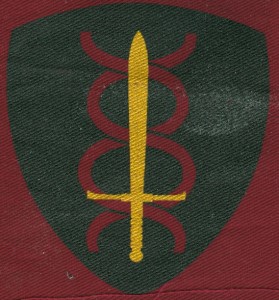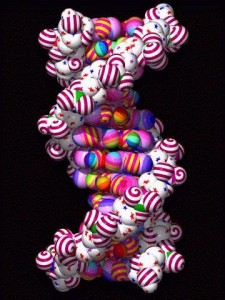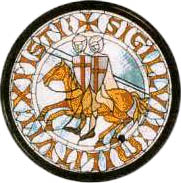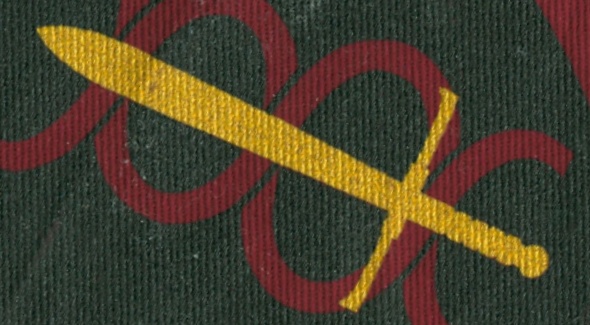
[This post is the distillation of a rambling email conversation. In an effort to keep it as well organized as possible, I have flagrantly collated, rephrased, and outright forged and stolen the words of my fellow writers. Any awkward prose or failed attempts at humor are certainly my fault, not theirs. –Stokes]
Although you wouldn’t know it from the look of things, Lee doesn’t have time to write about EVERYTHING he saw at comiccon. So he tossed this one over to the team.
What you see above is the armband worn by soldiers in the Human Resistance. Or more accurately, what you see is a piece of viral marketing connected to the upcoming Christian Bale movie, Terminator: Salvation. But what does this bizarre hodgepodge of symbols mean?
Resident structural biochemist Shechner got the ball rolling.

Real DNA is made of Peppermint and Chewing Gum.
“Considering that this is a struggle between the (biological) humans and the (exceedingly non-biological) robots, and considering that the fundamental blueprint for biological life looks sort of spiral-y, they’re probably *trying* to represent a DNA duplex. But they’re not succeeding. And the media aren’t helping them out, frankly; this logo falls prey to two common mistakes a LOT of people make when drawing DNA double-helices. Proper DNA looks like this.
“Notice that the spiral is“right handed,” and that the loops aren’t equally spaced (they alternate long and short, as it were, which is called having major and minor grooves). These are things that DNA basically always does, and the Resistance logo never does.”
Basically always? Well, Shechner proceeded to inform us that there is “left handed” DNA, called Z-DNA, but that it forms a “crooked zig-zag” rather than an elegant spiral. The rest of us proceeded to give him a wedgie and stuff him in a locker.
Not to be outdorked by a biochemist, resident classicist Fenzel made an intriguing counterclaim:
“The resistance logo is meant to evoke the Caduceus, the staff of Hermes; or possibly the rod of Asclepius (which has been confused for the Caduceus so often that the symbols are inextricable). The Caduceus was a symbol for a lot of stuff, but most notably:

Also a symbol of neutrality, which sends something of a mixed message.
- The messenger bringing the living into the land of the dead
- The U.S. Army Medical Corps (by accident)
- People who are really fleet of foot
- Thieves
- Merchants
- Liars
- Printers

Come With Me If You Want To First Do No Harm!
“The rod of Asclepius is just a single snake wound around a stick, sans wings, and it is the symbol of doctors. (To keep the symbols straight, remember this simple mnemonic: Doctors Can Not Fly). It’s an interesting and compelling symbol to us, because in that context, the snake represents rebirth (because it sheds its skin), but we generally associate snakes with the power over life and death (because they are known as generally poisonous). That means the symbol has a sort of ambiguous, powerful place between people who can save us or people who wield an intimidating power that might kill us, or who just hang out around death all the time.
“The resistance symbol also uses a stylized longsword, which is similarly ambiguous, because it’s a military symbol and is used to kill people, but it’s also cruciform, which means that it recalls Jesus.
“All these things seem thematically relevant when discussing the Resistance. John Connor is definitely a Christ figure (JC!), and he leads a band of quick, devious, tricky folks who are at once killers and live among a lot of death, but are also looking to heal and save the world. (They probably reproduce books through samizdat, but six out of seven ain’t bad.)
“Finally, we should remember that it’s a Coat of Arms that appears on a shield-shaped field, not just a round patch or logo. I guess the helices make it futuristic, but the sword and shield basically say they’re a secret brotherhood of Knights trying to get back the Holy Land or something.”
Alas, after an impressive routine, Fenzel failed to stick the landing:
“But also, I suspect the graphic designer was looking at a lot of old army insignias and liked the ones based on the Caduceus.”
Ooh! He was fined two points for excessive underthinking, and lost control of the ball. Luckily, it was picked up by Comicon stalwart Mlawski, who reinforced his last point:

Dude, I so called shotgun on this horse!
“Yeah, my mind immediately went to the Knights Templar. Then again, my mind often goes directly to the Middle Ages without stopping at go or ‘DNA double helices.'”
Galvanized, Fenzel charged once more into the breach.
“The history of the Knights Templar could be pretty relevant here.
“The Knights were supposedly a financially poor band of very dedicated and highly experienced soldiers who defended the site of Solomon’s temple from assault during the Crusades.
“They then expanded to become one of the dominant political forces in Europe and the near East, through two main trades: they offered protection and safe houses to pilgrims traveling to the Holy Land, and they started a system of related safety deposit boxes that expanded into a dominant banking empire (the ancestor of today’s large German banking sector).
“They never had a ton of soldiers, but the ones they had tended to be very well trained and well equipped. They had a lot of supporters throughout Europe and members who weren’t really soldiers running the banking business and generally supporting them. The Pope loved them, and they got a ton of special favors and exemptions from taxes. Most major heads of state were in debt to them pretty heavily.
“And then, on Friday the 13th, 1307, there was a massive operation by the King of France to pretty much round up all the French ones, seize their assets and execute them. The same thing was repeated across Europe with the Pope’s blessing a few months later. (Spoiler alert: this is basically what happens at the end of Revenge of the Sith.)
“So, if the Resistance is modeled after the Knights Templar – a small band of elite fighters with a charismatic leader that expands to become a powerful force in the world standing against the Terminators – expect them at some point to be betrayed by an influential ally and decimated. And if they’re being compared to Germany (through the Templar associations and also the colors, although I guess it could be Belgium or Uganda), expect there to be a lot of talk about whether John Connor is shaping up to be a dictator, and whether people are better off exchanging the tyranny of the machines for the tyranny of man. Sounds like it could kill about twenty minutes of screen time between action sequences.”
Compelling stuff! And while we’re getting medieval, what about the sword? Here the humble editor of this post supplied the following information, all of which was cribbed from wikipedia.
“As to the type of sword, they’re playing up the cruciform angle big-time. Notice that the crossbar is something like 25 per cent of the length of the sword. That’s quite rare for an actual weapon… the only pictures I found with similar proportions were German Zweihanders. And it’s clearly not just based on one of those: the blade is too wide, and shouldn’t expand at the tip. It looks much more like a cross than like a sword, is what I’m trying to say. (Fenzel, who actually used to fenze–uh, fence–pointed out that a sword like that would be incredibly awkward and prone to breaking: “Even a khopesh is better balanced than this, and that’s already pretty close to not being a sword.”) In any case, it’s definitely a European sword. Not a scimitar, not a machete… that may be the single most important thing.”
Around about here, Belinkie came along and pulled the rug out from under us…
“The idea of the Resistance having a symbol at all is a little weird. Or at least, interesting. On the one hand, symbols and slogans and feeling like you’re part of a movement is critical when you’re trying to inspire people. But… well, it depends how the Resistance is presented in the movie. Are they a small group that’s just beginning to recruit people? Or are they the only game in town?”
In other words, the question isn’t “Why this logo?” it’s “Why any logo?”
There are a number of possible answers within the world of the film. Belinkie suggests some of these, such as the importance of symbols as a rallying point. But again, this isn’t just a symbol. It’s a military insignia, and not one that represents a particular rank, but the most basic one, the one that simply says “the bearer is a member in good standing of the Resistance.”
This is really interesting. The resistance in all the other Terminator movies is strictly a guerrilla affair, aren’t they? Sure, some of them have ranks, but it’s basically just a bunch of dudes in grubby street clothes fighting a war of attrition against the robot horde. There’s lots of hiding in rubble, lots of shooting down of gunships with shoulder-mounted rocket launchers. This was fine for Terminators 1 through 2. In the 80s and the early 90s, our main image of guerrilla warfare was still Vietnam, and the scars had faded enough that Americans were only too glad to dress up as vietcong: to imagine ourselves as the scrappy underdogs struggling to protect our homeland, and someone else as the overpowered but clumsy foreign invaders. (Exhibit A.)
In this new Terminator film, the resistance is apparently regular army. Insignia plays a crucial role here: wearing fixed and visible insignia is one of the things that qualifies you for POW status under the Geneva conventions. But obviously the Terminators aren’t playing by those rules, which means that the insignia isn’t really for them. It’s for us, the viewers, letting us know that John Connor is a noble soldier, not an ignoble terrorist.
In other words, he is professional.
The last word goes to Lee, who apparently DOES have time to comment on everything after all. “Whatever the meaning of this logo,” he writes, “I’m sure the sales and recruitment wing of the Resistance was grateful to finally get some consistent branding guidelines. Different satellite offices were using their own homegrown logos, which was confusing both the target demographic and the competition.It couldn’t have come at a better time for the team, which is in the midst of a grueling recruitment competition. First prize is a trip back in time pre-Judgement Day. Second prize is a set of liquid metal steak knives. Third prize is, of course, You’re Terminated.”

If they are building on the mythology from the Sara Connor Chronicles, then there are multiple factions among the human survivors in the future, and the insignia may actually demonstrate alliance with or allegiance to a particular faction.
You know, this is actually something that Lee, Mlawski and I learned at ComicCon. No less an authority than McG himself said that the film will take place in a universe separate from T:SCC, and be faithful to the first two Terminator movies (borrowing only the altered timeline and date of Judgement Day from T3).
Though while we’re at it (Sarah Connor Chronicles spoilers ahead), I think you’re right about human factions in the future. Do you agree that the issue they seem to split over is whether JC (amazing coincidence, those initials) is still a good leader of the resistance, or whether he spends all his time with his robot sex toy?
So, it’s basically _Reign of Fire_, except with robots instead of dragons?
@Wrather, depends on which John Connor you’re talking about.
By my understanding of time travel, with every instance of traveling through time, a timeline forks. So the John Connor of the “original” timeline who sent Kyle back to stop the first Terminator is a totally different JC than the one who survived the events of T2, who is a totally different JC who survived the events of T3, who is a totally different JC who survived the attack in the school in the T:SCC pilot, etc. etc. etc.
So basically, what we’re seeing in T:SCC is the repercussions of a timeline in which a future JC has been so messed up by all of the experiences that led him to the leadership of the Resistance that he can’t think straight. Which I think is totally plausible.
@lee — I agree that that seems to be the T:SCC model of time travel.
(I pause here to note, though, that nothing seems actually to avert Judgment Day — it’s like it’s fated to happen and will happen in some form or other no matter what — which makes the Terminator model of time travel kind of a compromise between the ancient Greek model [you can’t fight city hall] and the “A Sound of Thunder” model, where a single timeline changes instantly when something in the past changes.)
Confirming your hypothesis (spoiler alert): When Reese and Hot Austrasian Kick-Ass Chick (forget her name) find Toby Ziegler and hold him hostage in a shipping container, and Reese doesn’t remember the guy from the future, it seems like the forking timelines theory comes true.
But then, why does H.A.K.A.C. come back to THIS timeline, instead of a separate one?
It’s going a bit far to say there are seperate factions in T:SCC. The fact that Jesse and Riley want to stop John seeing Cameron doesn’t qualify them as being a different faction.
And like Derek said, there was only 5 Greys, including Fisher. So once again, doesn’t really qualify a seperate faction.
I’d say the bigger reason for the Resistance wearing insignia is to identify themselves from regular people. There’s still large numbers of people left alive, and only some are Resistance.
I guess we’ll have to wait for the movie (unless someone has insight) to find out what significance the number eight has. The snakes or DNA strands, whatever they may be, appear to form the number 8 centered behind the sword. The top oval is obviously smaller than the lower one as they are formed by the overlapping lines. So what is the number eight in Terminator lore, or is this a new thing?
Well, maybe they hope that the rule of mercury/hermes prolonges
much longer then it has(or will last actually), it is the symbol of trade here in europe.
Do you remember that the writer of harry potter made a statue
in honor of mercury/hermes, which only makes sense if she is thanking for the huge amount of money she made. Otherwise she would have thanked the muzes.
remember the thunderdome, the mad max movies, what does the guy in the cage have. The winged wheel, symbol of transportation. Why did financial institutions have bulding consisting of two towers? The two pillars, janich and boaz, which also is what the templars cross actually represents.
And how many banks have the caduceus somewhere in their building, just watch TV and see that most did. If you had eyes you could have seen these couple of last months.
Ah , |I won`t tell too much, it is much more fun to discover it all yourself, just keep your eyes open and look up, especially buildings made around the 1900’s
)O+->
“JC (amazing coincidence, those initials)”
Yeah, if James Cameron is known for one thing, it’s subtlety. ;)